National Park "Taganai"
“Picturesqueness and originality of mountain landscapes” were terms used by numerous scientists, travellers, artists and writers when referring to the mountains Yurma, Taganai, Itsyl of the southern Urals. These beautiful places, frequently compared with well-known alpine landscapes, are known as the “Russian Switzerland” and the “Ural Tyrol”.
In order to preserve these unique nature wonderlands of the southern Urals, in 1991 the first nature national park in the Urals - “Taganai” was established. “Taganai” is located in the western part of the Chelyabinsk district, adjoining the northern suburbs of the town Zlatoust, and it covers an area of 564 sq. km.
The park stretches from north to south 52 km and from east to west 10-15 km.
“Taganai” includes some small ridges of the southern Urals - Big Taganai, Yurma, Itsyl, Middle Taganai and Small Taganai.
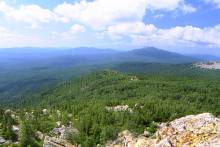 |
|
Here are preserved many ecological systems in practically pristine condition - mountain tundra and meadows, sparse growth of trees at the base of mountains and relic forests. The beautiful nature of the park has always attracted the attention of many tourists from all over Russia.
Within the park are situated ancient mineralogical mines - Akhmatovskaya, Nikolay - Maksimiliannovskaya, Eremeevskaya, Zelentsovskaya, iron -Tesminskii and Taganaiskii and copper - Evgrafovskii and Nadezhdinskii, whose mineral samples are exhibited in many mineralogical collections in different museums around the world. In "Tagnai" it is possible to find more than 70 kinds of minerals and stones.
In the territory of “Taganai” the largest deposit in Russia of the beautiful stone “Taganaiskoe” - aventurine (the local name - taganait) is situated.
Located in the park are 8 geomorphologic (including well-known the ridge “Otkliknoi”), 4 geological, 2 botanical and 6 hydrological natural monuments, as well as natural-landscape zones - mountain tundra, middle tundra, southern tundra, mountain taiga, coniferous - broad-lived forests, and forest-steppe.
Bordering on the park is a watershed between the two largest river basins of Russia – the Volga-Kama and the Ob - Irtysh basins. The park’s river network divides into the rivers Big Kialim flowing into the Caspian Sea in the south and the Kusa with its numerous tributaries and a few small rivers - Shumga, Big and Small Tesma and Black flowing into the Arctic Ocean in the north.
The park contains many mountain streams - the most well known of these is the Belyi Klyuch (White stream) on the eastern slope of Mt. “Two-headed Hill”. Water in these streams is weakly mineralised and in summer the water temperature does not exceed +16OC, however in the “White stream” - only from +3OC up to + 4OC.
In the Kialimskaya ravine (of tectonic origin), is situated the “Big Moss Bog” (a natural monument), that covers an area of 36 sq. km and it is the fifth in size from the 12 largest bogs in the Chelyabinsk district.
The park represents a mountain system of sub-meridianal ridges. In the western part the Nazminskii ridge (height reaching 884m asl) and its northern continuation, the ridge “Dlinnyi Mys” (Long Cape) with an average height of about 600 ì are situated. In the central part is located the Taganaiskii mountain massif, consisting of three ridges – the 20 km Big Taganai with four peaks, the Two-headed Hill (1034 m in the south and 1041 m – in the north) and the ridge “Otkliknoi” (1155 m), Kruglitsa (1178 m) and Dalnii Taganai (Distant Taganai), (1112 m); Middle Taganai (height – 959 m) and Small Taganai (height – 1033 m). To the northeast, the ridge Big Taganai passes in the ridge Yurma. The park is bounded in the east by the Ural ridge (930 ì) passing in the north to the ridge Itsyl (1068 m). As usual the upper part of the mountains is rocky and inaccessible with rocks of amazing shapes and abrupt slopes. The “Otkliknoi” ridge is the most impressing. On the slopes of the mountains Kruglitsa and Itsyl is a continuous conglomeration of large boulders (local name – “kurum”). These stone taluses “flow down”, forming at the foot of mountains “stone rivers” – the largest of which is the 6 km Big Stone River with a width of 100-200 m. in the saddle between Two-headed Hill and Middle Taganai.
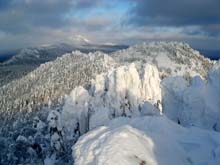 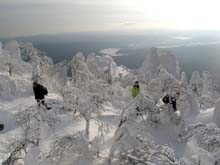 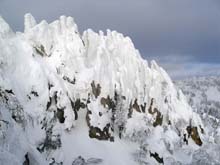
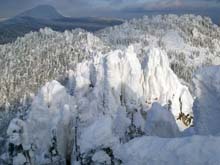 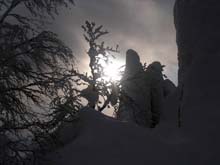 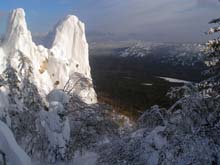
The park is located on the border of two climatic zones – Atlantic-forest and continental Western-Siberian but on the whole, the territory of the park characterized by a cool and damp climate with westerly winds prevailing. In territory of the park are two various climatic zones, the first of which – from the forests and meadows at the foot of mountains to the upper parts and the second – the mountain foots and valleys. The forested part of the park covers more than 90% of the whole territory and is mostly coniferous forests. This coniferous zone is situated at heights between 650-1000 m above the sea level. Above it the sub alpine meadows, mountain tundra and stone slide-rocks are distributed.
Cloudy weather is most typical for mountains on the ridges of the park
Fauna and flora are abundant and diverse - 52 species of mammal, 126 species of birds, 7 species of fish, 5 species of reptiles and 687 types of the plants - among them 45 species are relic, 14 endemic of the Urals and 20 were recorded in “The Red Book” (the book in which rare species of flora and fauna are described). In the small territory of the park are animals and plants characteristic for the whole of Russia. The relic fir groves on the Itsyl ridge are of immense value.
From the nine groups of mammals throughout Russia six are found here in the park. The most ancient representatives of this class are the insectivorous (hedgehogs, European moles and shrews) and from the chiropters is the grey bat. The specific structure of rodents, among them squirrels, field-voles and forest lemmings is various. From the artiodactyls are the elk, roe and wild boar.
Amongst the predators are weasels, ermine, Siberian weasels, martens, badgers, wolves, foxes, raccoons, brown bears and lynx.
Wintering birds such as cedar waxwings, redpolls and hawk owls can be found, birds of passage - snowy owls, snow buntings, bullfinches, crossbills and cedarbirds are common. There are many wood grouse, black grouse and hazel grouse while some birds like the golden eagle, see eagle, eagle owl and fish-hawk are very rare and are protected.
In forests there are a lot of birds nesting in hollows of trees - woodpeckers, titmouse, chickadees, and flycatchers.
 
|

